This homemade sauerkraut recipe is an easy way to get gut healthy probiotics in your daily diet. Enjoy it as a side to a meal or add it to your favorite sandwich.
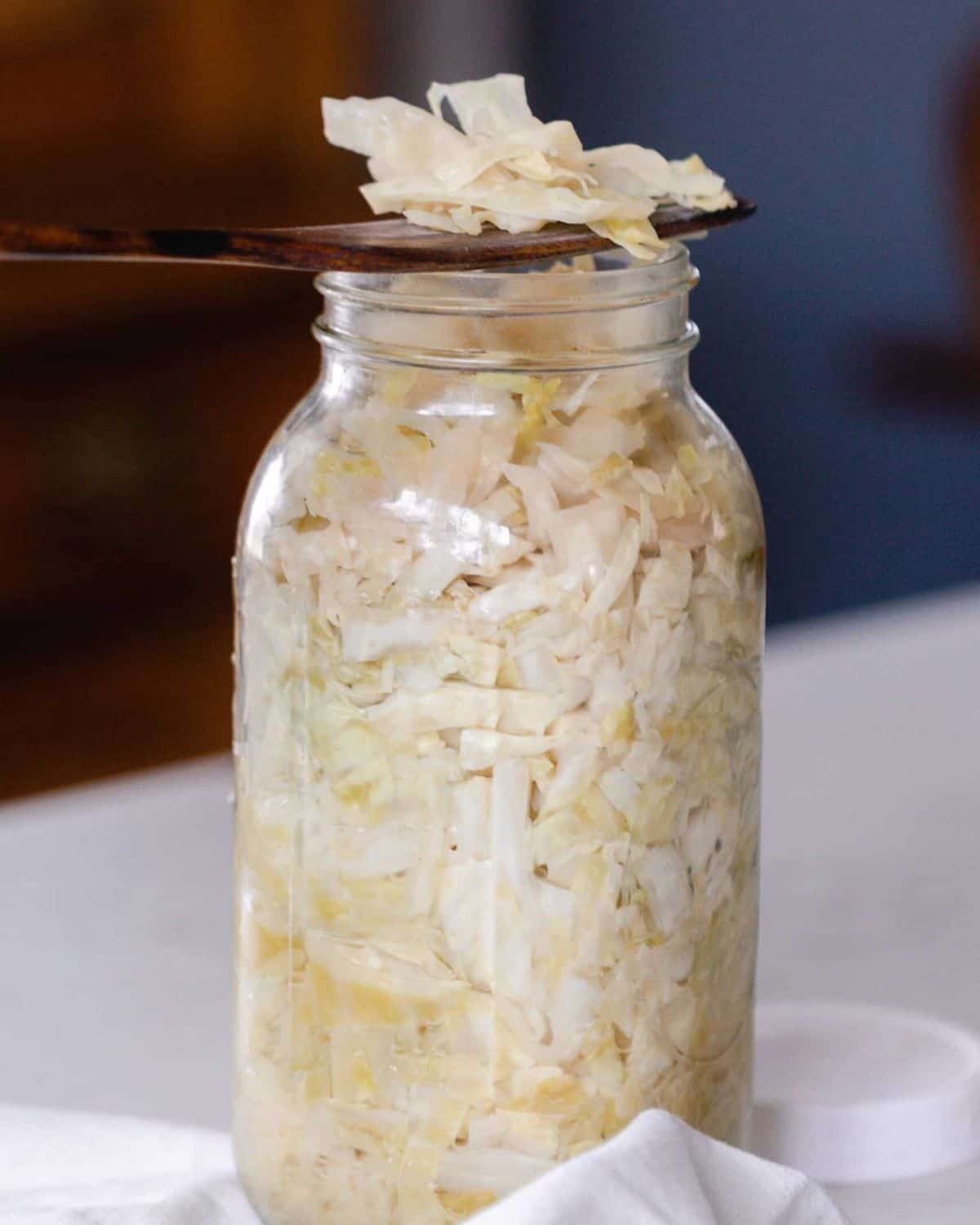
This post contains affiliate links, which means I make a small commission at no extra cost to you. See my full affiliate link disclosure here.
Now more than ever we are seeing the importance of gut health to our overall well-being. Probiotics play a big role in the state of our gut.
You could spend $50 a month or even more on supplements, or you could incorporate fermented foods into your daily diet instead!
This homemade sauerkraut is one of our favorite ways to get our probiotics in, along with raw milk yogurt in the instant pot, milk kefir, and water kefir sodas.
It only takes about 15 minutes of hands on time and a little patience waiting for it to ferment. Add it to a cold cut sandwich wedged between two slices of sourdough rye bread or even on top of a grilled hot dog on a sourdough hot dog bun.
Why You’ll Love This Recipe:
Easy and delicious – All you need are two simple ingredients – salt and cabbage – to make this tangy, crunchy dish.
Inexpensive – True fermented raw sauerkraut at the grocery store that hasn’t been canned, which kills the good bacteria, can be pricey. Making a large batch yourself is a fraction of the price. Plus, homemade always tastes better!
Packed with gut-healthy probiotics – When salt and cabbage are massaged together and allowed to sit for a few days, lactobacillus bacteria, the good kind also known as probiotics, starts to populate. Regular consumption of fermented foods have been shown to have many health benefits, including improved digestion, increased immunity, and reduced inflammation (source).
Tools You May Need
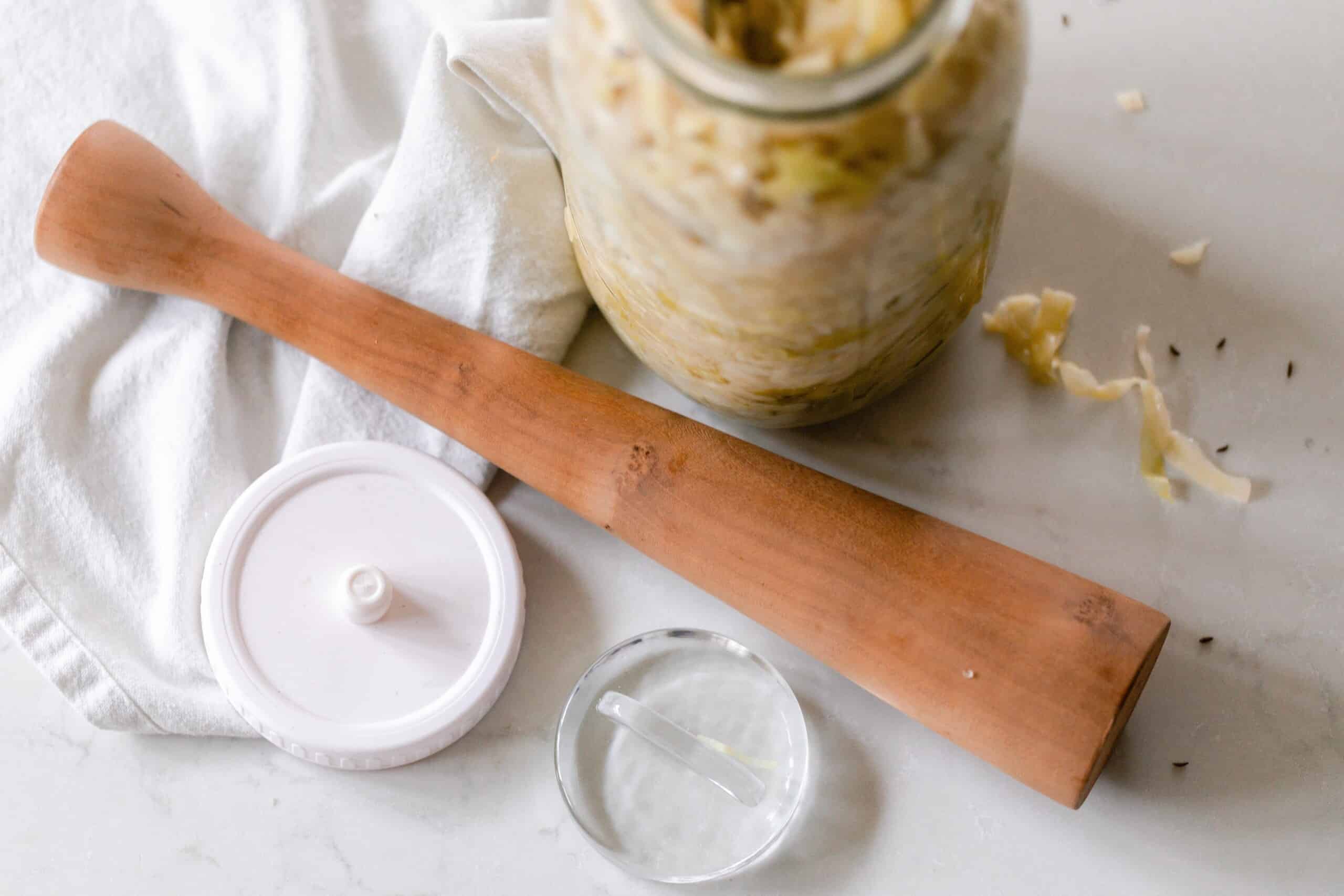
Fermentation kit – You can get away without one, but if you plan to do a lot of fermenting, this really comes in handy!
Glass jar or fermentation crock – I usually just use a large mason jar.
Ingredients
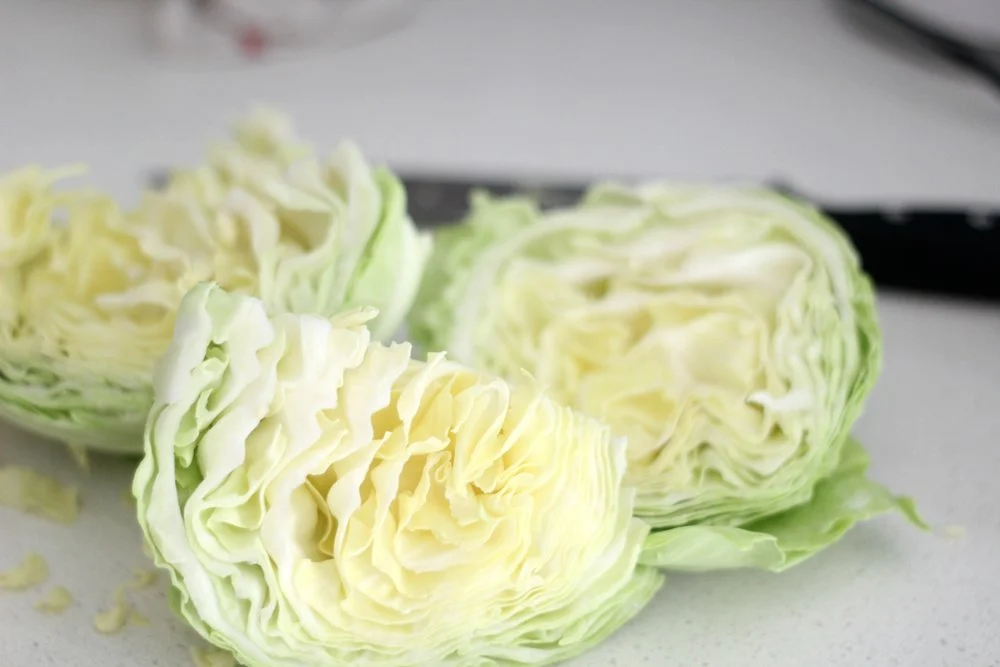
Salt – Choose sea salt, kosher salt, or pink Himalayan salt.
Cabbage – I typically use green cabbage, but you can use other varieties. I also try to buy organic if I can.
Homemade Sauerkraut Variations
You can add in a variety of ingredients to add flavor to your sauerkraut. Here are a few of our favorites:
- Caraway seeds
- Juniper berries
- Dill
- Shredded fennel or fennel seeds
- Beets – Also try my fermented beets recipe!
- Garlic
How To Make Homemade Sauerkraut

Step 1: With clean hands, pull off a few of the outer leaves from the top of the cabbage and set aside for the last step.
Next, core the head of cabbage and cut it into pieces small enough to fit in your food processor. If you do not have a food processor, just cut it into shreds or grate with a box grater. If you do have one, this part will go a little faster.
Place into a food processor and shred.
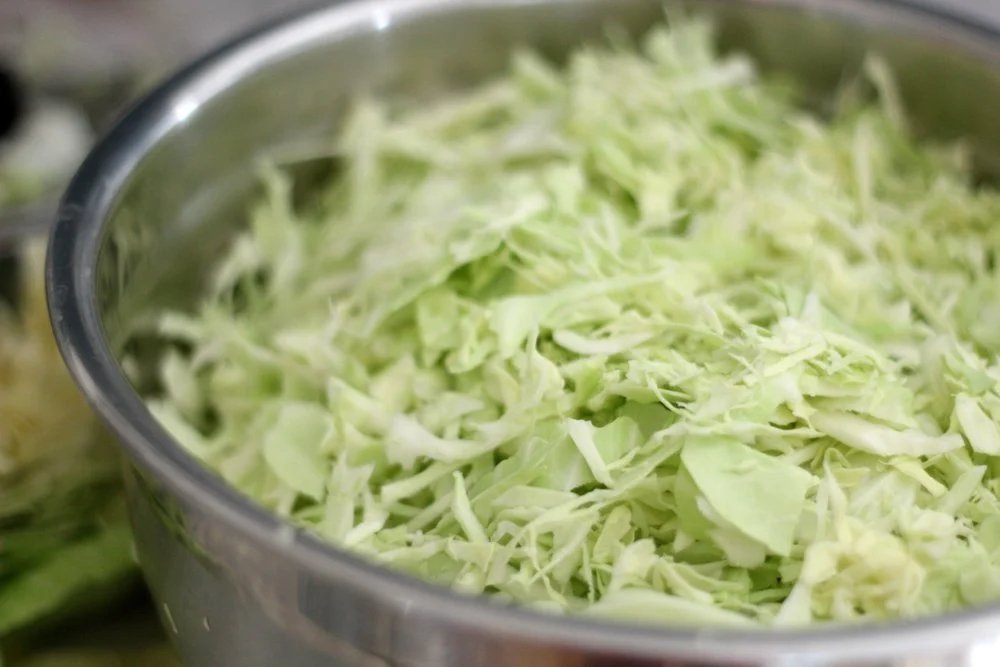
Step 2: Put the shredded cabbage in a bowl and sprinkle with salt.
For 5 pounds of cabbage, use 3 tablespoons of salt. I had 3.5 pounds, so I used 2 tablespoons.
Work the salt in with your hands until it starts to get juicy. The juice that is created when massaging the cabbage and salt together is the brine. You may have to work it for several minutes before it creates enough brine to move onto the next step. You can also use a wooden spoon to do this.

Step 3: Next, put all the fresh cabbage and the brine into a clean jar (you could use a fermentation crock, half gallon, or quart jars). Punch it down until all the cabbage is submerged beneath the brine.
Fold up the leaves you reserved earlier and place layers of cabbage on the top to keep all the cabbage down beneath the brine.
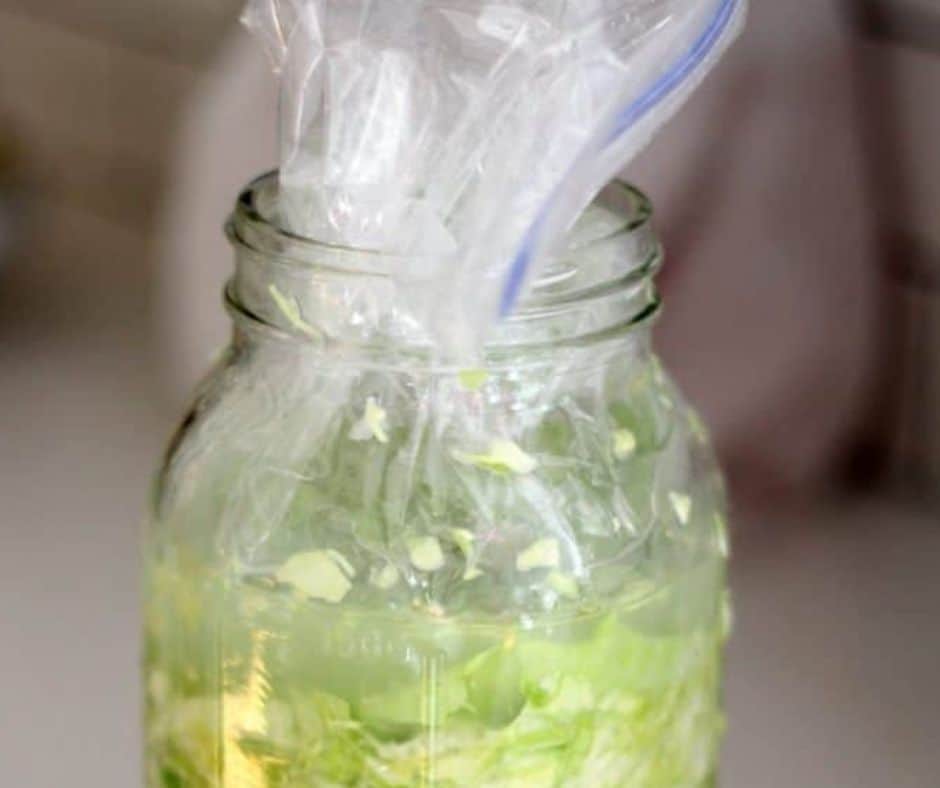
Step 4: Place a fermentation weight on top and press down making sure there is enough brine to cover all of the cabbage.
You could also place rocks in a ziplock bag and place the ziplock on top of the folded up cabbage leaves and the weight should be enough to keep all of your shredded cabbage beneath the brine. If any raw cabbage is above the liquid it will be exposed to oxygen and possibly mold, so that is why it is so important to keep it under the liquid.
Add a lid or a fermentation lid to the top of the jar.
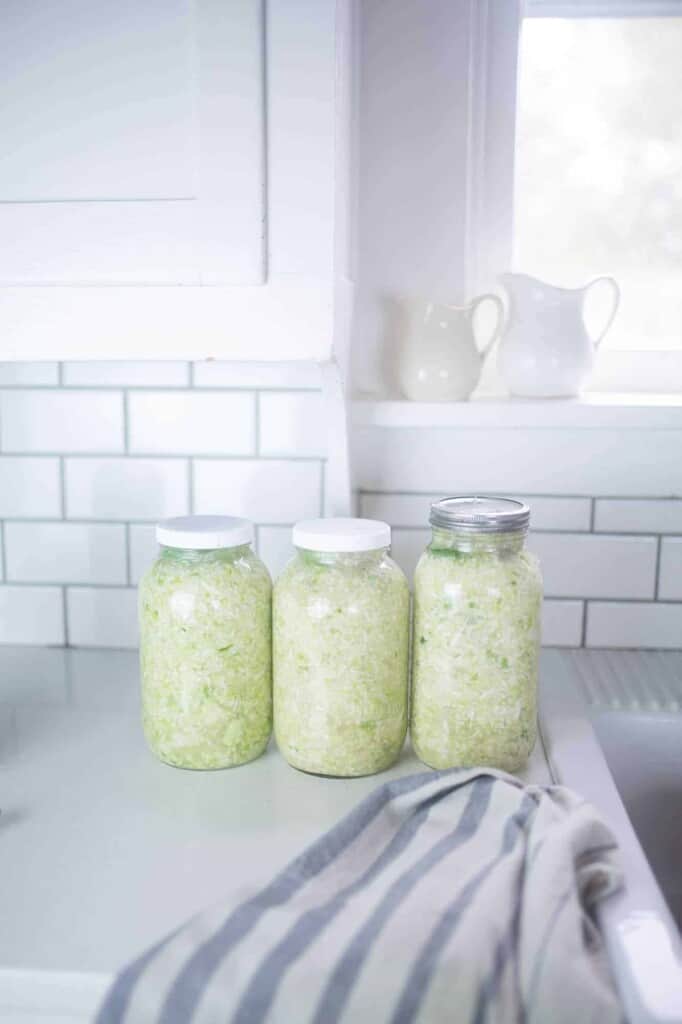
Step 5: Leave it out on the counter at room temperature for 5 days to 3 weeks, preferably out of direct sunlight. It will just become more pungent as it sits. Taste after a few days to see if the desired tangy flavor has occurred. If this is your first time trying homemade sauerkraut, it may be better to ferment it for less time.
You may want place the jars on a pan or baking dish just in case the brine spills over. The jar may also need to be burped if not using a fermentation lid.
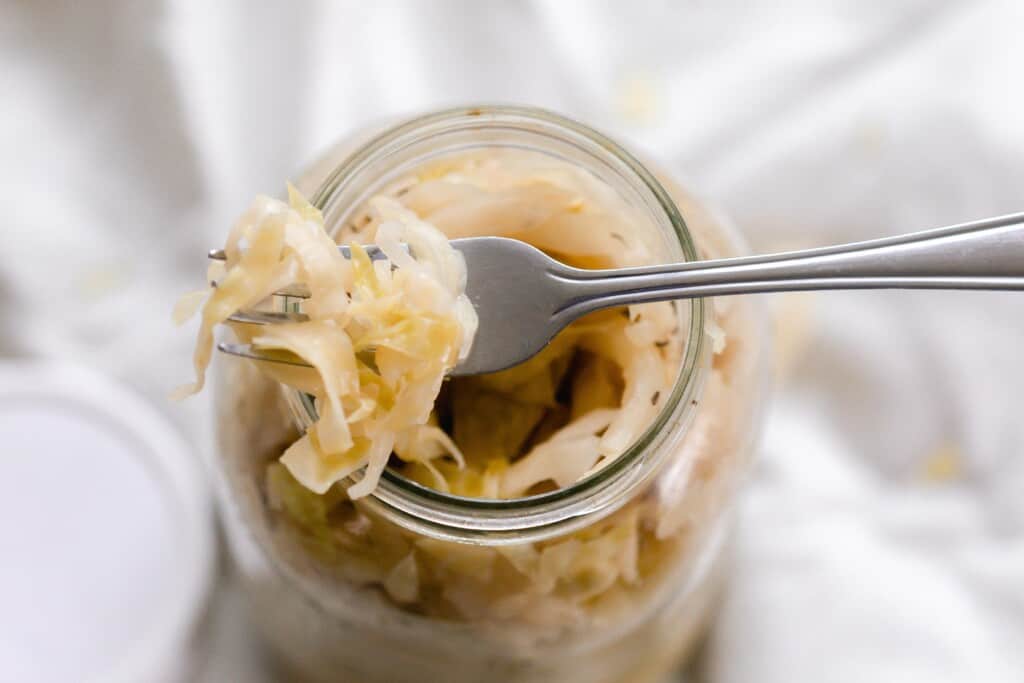
Step 6: Remove fermentation weight and folded up cabbage leaves, put the lid on the jar and store in the fridge.
Serve as a snack or side to dinner, like my easy salmon burgers.
Tips For Making Homemade Sauerkraut
- I love using glass fermentation weights, but if you don’t have any you can use clean rocks in a sealed ziplock bag.
- Those who are new to sauerkraut may want to try fermenting for 3 days at first before any longer fermentation period.
- If any cabbage is above the liquid it will be exposed to oxygen and possibly mold, so that is why it is so important to keep it under the liquid.
- A food processor makes this process really simple, if you don’t have one you can just chop it as finely as possible.
- Not using enough salt may cause harmful bacteria to grow. The point of the salt is to keep the unwanted bacteria out and only allow the good bacteria to flourish. For every 5 pounds of cabbage, use 3 tablespoons of salt.
Recipe FAQ’s
Sauerkraut is sliced cabbage that has been fermented. Regular sauerkraut from the store may not have been fermented as long or has been canned killing a lot of the beneficial lactic acid bacteria.
It can take 5 days to 3 weeks for sauerkraut to ferment. It will depend on the environment and temperature during the fermentation process. Warmer conditions speed up the fermentation.
Properly prepared and stored in dark cold storage (like the refrigerator), it can last at around 6 months.
Look for any signs of mold, an even color throughout, and that it still looks edible. Make sure to keep the lid tight in refrigeration storage (after the fermentation process).
Use your nose to see if it still smells as it should. It shouldn’t smell off and make sure the texture is still good, and not mushy. Lastly, give it a little taste to make to make sure it tastes good.
You can eat it warm or cold, but for probiotic purposes you should eat it cold since heating it can destroy the beneficial bacteria. Here are a few ways to enjoy it straight from the fridge:
– As a side to lunch or dinner. It is especially good on nights we serve my best homemade meatloaf recipe or sourdough fried chicken.
– As a topping to a salad, sandwich, or hot dog.
– As an additional topping to a freshly baked sourdough pizza. It may sound odd, but I promise it is really yummy.
More Fermented Foods From The Farmhouse Kitchen
If you try this recipe and love it, I would love it if you could come back and give it 5 stars! Tag me on Instagram @farmhouseonboone.
How To Make Sauerkraut
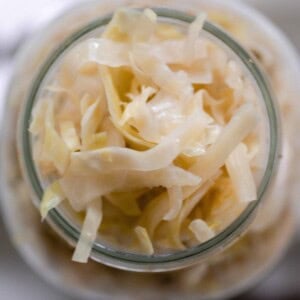
Equipment
- 1 Food Processor
- 1 Glass Fermentation Weights optional
Ingredients
- 3 heads cabbage
- 2-3 tablespoons salt
Instructions
- Pull off a few of the outer leaves and set aside for the last step.
- Next, core the cabbage and cut it into pieces small enough to fit in your food processor. If you do not have a food processor, just cut it into shreds. If you do have one, this part will go a little faster.
- Put the shredded cabbage in a bowl and sprinkle with salt.
- For 5 pounds of cabbage, use 3 tablespoons of salt. I had 3.5 pounds, so I used 2 tablespoons.
- Work the salt in with your hands until it starts to get produce a juicy brine. You may have to work it for several minutes before it gets juicy enough to move onto the next step.
- Next, put all the cabbage and the brine into a half gallon mason jar. Punch it down until all the cabbage is submerged beneath the brine.
- Fold up the cabbage leaves you reserved earlier and place on the top to keep all the cabbage down beneath the brine.
- Place fermentation weight on top of the folded cabbage and press it down until all of the cabbage is submerged in the brine.
- Leave it out on the counter for 5 days-3 weeks. It will just become more pungent as it sits. If this is your first time trying homemade sauerkraut, it may be better to ferment it for less time.
- Remove the weight and folded up cabbage leaves, put the lid on the jar and store in the fridge.
Notes
-
- I love using glass fermentation weights, but if you don’t have any you can use clean rocks in a sealed ziplock bag.
- Those who are new to sauerkraut may want to try fermenting for 3 days at first before any longer fermentation period.
- If any cabbage is above the liquid it will be exposed to oxygen and possibly mold, so that is why it is so important to keep it under the liquid.
- A food processor makes this process really simple, if you don’t have one you can just chop it as finely as possible.
- Not using enough salt may cause harmful bacteria to grow. The point of the salt is to keep the unwanted bacteria out and only allow the good bacteria to flourish. For every 5 pounds of cabbage, use 3 tablespoons of salt.
Nutrition
Nutrition information is automatically calculated, so should only be used as an approximation.




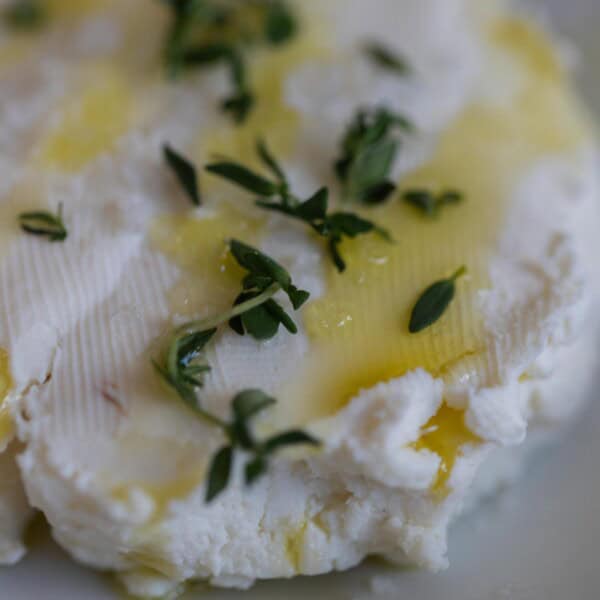






So simple. This time I made both green and purple kraut and even fermented an organic green bell pepper that was going south. I added some carrots to it to fill up the jar. We’ll see how that goes but it only cost me a little salt. Waste not want not!☺️
Can you explain what you mean by “burping” if we don’t have any if the fancy equipment?
Burping is simply opening the lid and letting some of the air/gas out!
Hi Lisa I tried the cabbage and let it ferment for a week and just looked at it: It seems pretty dry. Is it supposed to be that way or did I do something wrong?
It usually produces more juice and is almost over flowing!
I’m on day 2 and I gave it a taste. It is so very salty. Will it be this salty still after the fermentation process?
Did your salt dissolve completely before adding the cabbage? You can keep testing it every day to see your desired saltiness level.
Hi, I wanted to double check on the type of salt you use to make the sauerkraut. I read on another website it must be non- ionized, but I noticed your recipe didn’t specify that. Is it OK to use ionized salt? Please let me know. I’m very excited to make your sauerkraut recipe. Thanks
I typically use Redmond’s Real Salt.
Thank you. I’ll look that up!
I’m excited to make sauerkraut.
Another question? I don’t have a fermentation lid I didn’t realize I needed one is it OK to just sit a loose lid on it? I’ll have to get some for next time. I have plastic ball lids I can just rest on top.loosely. Thanks for your help.
Yes, you can just add any type of lid loosely. You just need some room for the kraut to breath.
Silly question – I processed 7 pounds of cabbage in my crock at 3pm (11-01-2023), can I add more cabbage to my crock (less than 48 hours into ferment)?
No, I would add it to a new batch!
How long does this last in the fridge after fermenting?
Properly prepared and stored in dark cold storage (like the refrigerator), it can last at least around 6 months.
Look for any signs of mold, an even color throughout, and it still looks edible.
Make sure to keep the lid tight in refrigeration storage (after the fermentation process).
Use your nose to see if it still smells as it should. It shouldn’t smell off and make sure the texture is still good, and not mushy.
Lastly, give it a little taste to make to make sure it tastes good.
Hi there! Im fermenting my first batch of sauerkraut now. I followed your recipe. My question is, is it ok to push down the sauerkraut once or twice a day or as needed? I have a sauerkraut pounder..thanks
That shouldn’t really harm anything. A weight on top will keep it submerged so you shouldn’t have to do that.
Hi How long should I leave fermenting before putting in fridge? Temperature has been hot here, approximately 27C to 33C, this is my 1st batch I’m making, your advice will be appreciated.
😊
I usually give it a little taste every day until it reaches the desired sourness!
Hi Lisa! I used your recipe above to make my first sauerkraut batch! My mom always did it, and now the time came for me to carry the tradish, so I decided to do it also. Will see how it turns out, but I’m sure it’ll be great just like all the things I made from your sourdough collection! Amazing recipes, everything tasted amazing! Thank you so much for doing what you do! God bless you and your beautiful family!🙌🏼
P.s. I added grated carrots (2-3) into the mix as my mom did that too, it’s more colorful that way and more vitamins 🙂
That is so amazing and special. I love how you want to continue a legacy and this recipe is part of it. Carrots sounds amazing.
You say “as long as it takes to ferment” but how would a beginner know when that has happened!?
You’ll want to check it everyday after the first few days. Taste it to see if it tastes tangy enough.
Hello! I followed your sauerkraut recipe and am so excited to try it for the first time😊 I just had a quick question do you keep the liquid in the jar or drain it out before storing in fridge?
I keep it in the jar!
Can you add acidic whey with this recipe? I’m making it for the first time and my aunt just dropped off acidic whey and I saw it can be used for sauerkraut. Have you tried this before? Thoughts on if I can just add it to your current recipe? Everything I’m seeing is adding water and other ingredients but I want to follow the simplicity of yours if possible
I have not tried that.